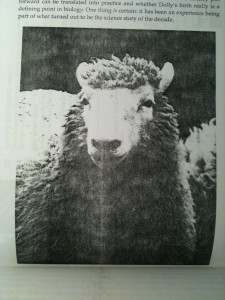 Ian Wilmut is best known for his involvement with the team which cloned Dolly the sheep in 1996. However, his scientific career, which spans more than five decades, includes a variety of groundbreaking achievements and discoveries, which are being revealed as his papers are catalogued as part of the continuing ‘Towards Dolly’ and ‘The Making of Dolly’ projects.
Ian Wilmut is best known for his involvement with the team which cloned Dolly the sheep in 1996. However, his scientific career, which spans more than five decades, includes a variety of groundbreaking achievements and discoveries, which are being revealed as his papers are catalogued as part of the continuing ‘Towards Dolly’ and ‘The Making of Dolly’ projects.
Ian Wilmut initially wished to work as a farmer, but he ‘shuffled sideways into scientific research’*, as he puts it, and ultimately won a scholarship as an undergraduate at Nottingham University to work for two months under Chris Polge at the Animal Research Station in Cambridge. His role was to help out generally with experiments, but he soon became fascinated by embryos, and returned to work with Polge once he graduated. Wilmut’s PhD, awarded in 1971, was on the freezing of boar semen. Copies of Wilmut’s published papers exist in the archive from 1969 onwards, and a glance through the papers which appeared over the next decade reveal Wilmut’s wide-ranging research on the effects of freezing, thawing and warming on embryos and spermatozoa in mice, sheep and cattle.
In 1973, Wilmut was the first scientist to successfully freeze a calf embryo (using liquid nitrogen), thaw it, and transfer it to a surrogate mother. This process led to the birth of a healthy red and white Hereford-Friesian cross calf, which Wilmut wryly named ‘Frostie’. Wilmut’s findings were published within a few weeks of Frostie’s birth in The Veterinary Record as ‘Experiments on the low-temperature preservation of cow embryos’ (June 30 1973, 686-690), and a copy of the reprint survives in the archives. Wilmut has remarked that this was ‘one of the fastest scientific publications ever’. It also led to some considerable interest from the world’s media, with Wilmut appearing on television and newspapers from as far away as New Zealand seizing upon the story. This media attention was a precursor to the storm which Wilmut, Keith Campbell and team would generate two decades later when Dolly the sheep was born. Wilmut’s discovery of the viability of frozen embryos to produce healthy offspring has since been used across many different species in agriculture and also for the conservation of rare breeds. The first human to be born from a frozen embryo was Zoe Leyland, born in Melbourne in 1984.
Wilmut’s work with Chris Polge equipped him with many of the techniques in reproductive physiology which would instruct his later work on cloning, nuclear transfer, stem cell and regenerative medicine in Edinburgh, where Wilmut moved in 1973. Throughout his career Wilmut has been inspired by the possibilities of advances in reproductive physiology and biotechnology for fertility treatments,practical applications to the farming industry and breakthroughs in treatments or cures for debilitating genetic diseases.
*All quotes taken from The Second Creation: the age of biological control by the scientists who cloned Dolly, I. Wilmut. K. Campbell and C. Tudge (London, 2000).
Clare Button
Project Archivist




